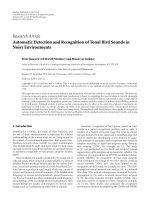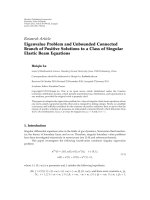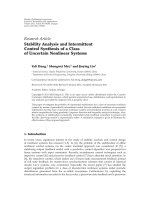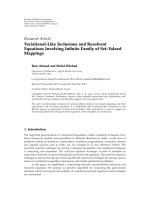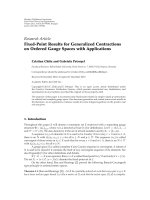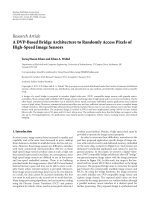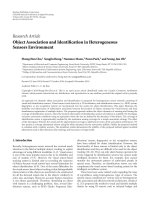Báo cáo hóa học: " Research Article Variational-Like Inclusions and Resolvent Equations Involving Infinite Family of Set-Valued Mappings" pdf
Bạn đang xem bản rút gọn của tài liệu. Xem và tải ngay bản đầy đủ của tài liệu tại đây (510.26 KB, 13 trang )
Hindawi Publishing Corporation
Fixed Point Theory and Applications
Volume 2011, Article ID 635030, 13 pages
doi:10.1155/2011/635030
Research Article
Variational-Like Inclusions and Resolvent
Equations Involving Infinite Family of Set-Valued
Mappings
Rais Ahmad and Mohd Dilshad
Department of Mathematics, Aligarh Muslim University,
Aligarh 202002, India
Correspondence should be addressed to Rais A hmad, raisain
123@rediffmail.com
Received 18 December 2010; Accepted 23 December 2010
Academic Editor: Qamrul Hasan Ansari
Copyright q 2011 R. Ahmad and M. Dilshad. This is an open access article distributed under
the Creative Commons Attribution License, which permits unrestricted use, distribution, and
reproduction in any medium, provided the original work is properly cited.
We study variational-like inclusions involving infinite family of set-valued mappings and their
equivalence with resolvent equations. It is established that variational-like inclusions in real
Banach spaces are equivalent to fixed point problems. This equivalence is used to suggest an
iterative algorithm for solving resolvent equations. Some examples are constructed.
1. Introduction
The important generalization of variational inequalities, called variational inclusions, have
been extensively studied and generalized in different directions to study a wide class of
problems arising in mechanics, optimization, nonlinear programming, economics, finance
and applied sciences, and so forth; see, for example 1–7 and references theirin. The
resolvent operator technique for solving variational inequalities and variational inclusions
is interesting and important. The resolvent operator technique is used to establish an
equivalence between variational inequalities and resolvent equations. The resolvent equation
technique is used to develop powerful and efficient numerical techniques for solving various
classes of variational inequalities inclusions and related optimization problems.
In this paper, we established a relationship between variational-like inclusions and
resolvent equations. We propose an iterative algorithm for computing the approximate
solutions which converge to exact solution of considered resolvent equations. Some examples
are constructed.
2 Fixed Point Theory and Applications
2. Formulation and Preliminaries
Throughout the paper, unless otherwise specified, we assume that E is a real Banach space
with its norm ·, E
∗
is the topological dual of E, ·, · is the pairing between E and E
∗
, d
is the metric induced by the norm ·,2
E
resp., CBE is the family of nonempty resp.,
nonempty closed and bounded subsets of E,andH·, · is the Housdorff metric on CBE
defined by
H
P, Q
max
sup
x∈P
d
x, Q
, sup
y∈Q
d
P, y
,
2.1
where dx, Qinf
y∈Q
dx, y and dP, yinf
x∈P
dx, y. The normalized duality
mapping J : E → 2
E
∗
is defined by
J
x
f ∈ E
∗
:
x, f
x
·
f
,
f
x
, ∀x ∈ E
. 2.2
Definition 2.1 . Let E be a real Banach space. Let η : E × E → E; g,A : E → E be the single-
valued mapping, and let M : E → 2
E
be a set-valued mapping. Then,
i the mapping g is said to be accretive if
g
x
− g
y
,j
x −y
≥ 0, ∀x, y ∈ E, 2.3
ii the mapping g is said to be strictly accretive if
g
x
− g
y
,j
x −y
≥ 0, ∀x, y ∈ E, 2.4
and the equality hold if and only if x y,
iii the mapping g is said to be k-strongly accretive k ∈ 0, 1 if for any x, y ∈ E,
there exists jx − y ∈Jx
− y such that
g
x
− g
y
,j
x − y
≥ k
x − y
2
,
2.5
iv the mapping A is said to be r-strongly η-accretive, if there exists a constant r>
0suchthat
A
x
− A
y
,j
η
x, y
≥ r
x − y
2
, ∀x, y ∈ E,
2.6
v the mapping M is said to be m-relaxed η-accretive, if there exists a constant m>
0suchthat
u − v, j
η
x, y
≥−m
x −y
2
, ∀x, y ∈ E, u ∈ M
x
,v∈ M
y
.
2.7
Fixed Point Theory and Applications 3
Definition 2.2. Let A : E → E, η : E × E → E be the single-valued mappings.
Then, a set-valued mapping M : E → 2
E
is called A, η-accretive if M is m-relaxed η-
accretive and A ρMEE, for every ρ>0.
Proposition 2.3 see 8, 9. Let E be a real Banach space, and let J : E → 2
E
∗
be the normalized
duality mapping. Then, for any x, y ∈ E
x y
2
≤
x
2
2
y, j
x y
, ∀j
x y
∈J
x y
.
2.8
Definition 2.4. Let A : E → E, W : E × E → E,andletN : E
∞
E × E × E ··· → E be the
mappings. Then,
i the mapping A is said to be Lipschitz continuous with constant λ
A
if
A
x
− A
y
≤ λ
A
x − y
, ∀x, y ∈ E, 2.9
ii the mapping W is said to be Lipschitz continuous in the first argument with
constant λ
W
1
if
W
x
1
, ·
− W
x
2
, ·
≤ λ
W
1
x
1
− x
2
, ∀x
1
,x
2
∈ E. 2.10
Similarly, we can define Lipschitz continuity in the second argument.
iii the mapping N is said to be Lipschitz continuous in the ith argument with
constant β
i
if
N
·, ,x
i
,
− N
·, ,y
i
,
≤ β
i
x
i
− y
i
, ∀x
i
,y
i
∈ E. 2.11
Definition 2.5. Let A : E → E be a strictly η-accretive mapping, and let M : E → 2
E
be an
A, η-accretive mapping. Then, the resolvent operator J
ρ,A
η,M
: E → E is defined by
J
ρ,A
η,M
u
A ρM
−1
u
, ∀u ∈ E.
2.12
Proposition 2.6 see 10. Let E be a real Banach space, and let η : E × E → E be τ-Lipschitz
continuous; let A : E → E be an r-strongly η-accretive mapping, and let M : E → 2
E
be an A, η-
accretive mapping. Then the resolvent operator J
ρ,A
η,M
: E → E is τ/r − ρm-Lipschitz continuous,
that is,
J
ρ,A
η,M
x
− J
ρ,A
η,M
y
≤
τ
r − ρm
x −y
, ∀x, y ∈ E,
2.13
where ρ ∈ 0,r/m is a constant.
4 Fixed Point Theory and Applications
Example 2.7. Let E
, Ax
√
x, My
√
y,andηx, y
√
x−
√
y for all x, y ≥ 0 ∈ E.
Then, M is η-accretive.
Example 2.8. Let M·, · : E × E → 2
E
be r-strongly η-accretive in the first argument.
Then, M is m-relaxed η-accretive for m ∈ 1,r r
2
,forr>0.6180.
Let T
i
: E → CBE,i 1, 2, ,∞ be an infinite family of set-valued mappings, and
let N : E
∞
E×E×E ··· → E be a nonlinear mapping. Let η, W : E×E → E; A, g, m : E → E
be single-valued mappings, let and B, C, D:E → CBE be set-valued mappings. Suppose
that M·, · : E × E → 2
E
is A, η-accretive mapping in the first argument. We consider the
following problem.
Find u ∈ E, w
i
∈ T
i
u,i 1, 2, ,∞,a∈ Bu,x∈ Cu, and y ∈ Du such that
0 ∈ N
w
1
,w
2
,
− W
x, y
m
a
M
g
u
− m
a
,u
. 2.14
The problem 2.14 is called variational-like inclusions problem.
Special Cases
i If W 0,m 0, then problem 2.14 reduces to the problem of finding u ∈ E, w
i
∈
T
i
u,i 1, 2, ,∞ such that
0 ∈ N
w
1
,w
2
,
M
g
u
,u
. 2.15
Problem 2.15 is introduced and studied by Wang 11.
ii If W 0,m 0,N·, N·, ·, then problem 2.14 reduces to a problem
considered by Chang, et al. 12, 13 that is, find u ∈ H, w
1
∈ T
1
u,w
2
∈ T
2
u
such that
0 ∈ N
w
1
,w
2
M
g
u
,u
. 2.16
It is now clear that for a suitable choice of maps involved in the formulation of
problem 2.14, we can d rive many known variational inclusions considered and studied
in the literature.
In connection with problem 2.14, we consider the following resolvent equation
problem.
Find z, u ∈ E, w
i
∈ T
i
u, i 1, 2, ,∞; a ∈ Bu, x ∈ Cu, y ∈ Du such that
N
w
1
,w
2
,
− W
x, y
m
a
ρ
−1
R
ρ,A
η,M·,u
z
0, 2.17
where ρ is a constant and R
ρ,A
η,M·,u
I − AJ
ρ,A
η,M·,u
,whereAJ
ρ,A
η,M·,u
z AJ
ρ,A
η,M·,u
z
and I is the identity mapping. Equation 2.17 is called the resolvent equation problem.
Fixed Point Theory and Applications 5
In support of problem 2.17, we have the following example.
Example 2.9. Let us suppose that E
, T
i
u−i, i, i 1, 2, ,∞, Cu{π/2}, Bu
0, 1,andDu{1}.
We define for w
i
∈ T
i
u,i 1, 2, ,∞,a∈ Bu,x∈ Cu and y ∈ Du.
i Nw
1
,w
2
, min{−1, sin w
1
, sin w
2
, },
ii masin
−1
a cos
−1
a,
iii Wx, yxy,
iv Axx − 1, for all x ∈
,
v M·,x1, for all x ∈
,
Then, for ρ 1, it is easy to check that the resolvent equation problem 2.17 is satisfied.
3. An Iterative Algorithm and Convergence Result
We mention the following equivalence between the problem 2.14 and a fixed point problem
which can be easily proved by using the definition of resolvent operator.
Lemma 3.1. Let u, a, x, y, w
1
,w
2
, where u ∈ E, w
i
∈ T
i
u,i 1, 2, ,∞, a ∈ Bu,x∈
Cu,andy ∈ Du, is a solution of 2.14 if and only if it is a solution of the following equation:
g
u
m
a
J
ρ,A
η,M·,u
A
g
u
− m
a
− ρ
N
w
1
,w
2
,
− W
x, y
m
a
. 3.1
Now, we show that the problem 2.14 is equivalent to a resolvent equation problem.
Lemma 3.2. Let u ∈ E, w
i
∈ T
i
u,i 1, 2, ,∞, a ∈ Bu,x∈ Cu,y∈ Du, then the
following are equivalent:
iu, a, x, y, w
1
,w
2
, is a solution of variational inclusion problem 2.14,
iiz, u, a, x, y, w
1
,w
2
, is a solution of the problem 2.17,
where
z A
g
u
− m
a
− ρ
N
w
1
,w
2
,
− W
x, y
m
a
,
g
u
m
a
J
ρ,A
η,M·,u
A
g
u
− m
a
− ρ
N
w
1
,w
2
,
− W
x, y
m
a
.
3.2
6 Fixed Point Theory and Applications
Proof. Let u, a, x, y, w
1
,w
2
, be a solution of the problem 2.14,thenbyLemma 3.1,itis
a solution of the problem
g
u
m
a
J
ρ,A
η,M·,u
A
g
u
− m
a
− ρ
N
w
1
,w
2
,
− W
x, y
m
a
, 3.3
using the fact that
R
ρ,A
η,M·,u
I − A
J
ρ,A
η,M·,u
,
R
ρ,A
η,M·,u
z
R
ρ,A
η,M·,u
A
g
u
− m
a
− ρ
N
w
1
,w
2
,
− W
x, y
m
a
I − A
J
ρ,A
η,M·,u
A
g
u
− m
a
−
ρN
w
1
,w
2
,
− W
x, y
m
a
A
g
u
− m
a
− ρ
N
w
1
,w
2
,
− W
x, y
m
a
− A
J
ρ,A
η,M·,u
A
g
u
− m
a
− ρ
N
w
1
,w
2
,
− W
x, y
m
a
A
g
u
− m
a
− ρ
N
w
1
,w
2
,
− W
x, y
m
a
− A
g
u
− m
a
,
3.4
which implies that
N
w
1
,w
2
,
− W
x, y
m
a
ρ
−1
R
ρ,A
η,M·,u
z
0, 3.5
with
z A
g
u
− m
a
− ρ
N
w
1
,w
2
,
− W
x, y
m
a
, 3.6
that is, z, u, a, x, y, w
1
,w
2
, is a solution of problem 2.17.
Conversly, let z, u, a, x, y, w
1
,w
2
, be a solution of problem 2.17,then
ρ
N
w
1
,w
2
,
− W
x, y
m
a
−R
ρ,A
η,M·,u
z
,
ρ
N
w
1
,w
2
,
− W
x, y
m
a
A
J
ρ,A
η,M·,u
z
− z,
3.7
from 3.2 and 3.7,wehave
ρ
N
w
1
,w
2
,
− W
x, y
m
a
A
J
ρ,A
η,M·,u
A
g
u
− m
a
− ρ
N
w
1
,w
2
,
− W
x, y
m
a
−
A
g
u
− m
a
− ρ
N
w
1
,w
2
,
− W
x, y
m
a
,
3.8
Fixed Point Theory and Applications 7
which implies that
g
u
m
a
J
ρ,A
η,M·,u
A
g
u
− m
a
− ρ
N
w
1
,w
2
,
− W
x, y
m
a
, 3.9
that is, u, a, x, y, w
1
,w
2
, is a solution of 2.14.
We now i nvoke Lemmas 3.1 and 3.2 to suggest the following iterative algorithm for
solving resolvent equation problem 2.17.
Algorithm 3 .3. For a given z
0
,u
0
∈ E, w
0
i
∈ T
i
u
0
,i 1, 2, ,∞, a
0
∈ Bu
0
,x
0
∈ Cu
0
,and
y
0
∈ Du
0
.Let
z
1
A
g
u
0
− m
a
0
− ρ
N
w
0
1
,w
0
2
,
− W
x
0
,y
0
m
a
0
. 3.10
Take z
1
,u
1
∈ E such that
g
u
1
m
a
1
J
ρ,A
η,M·,u
1
z
1
. 3.11
Since for each i, w
0
i
∈ T
i
u
0
, a
0
∈ Bu
0
,x
0
∈ Cu
0
,andy
0
∈ Du
0
by Nadler’s
theorem 14 there exist w
1
i
∈ T
i
u
1
,a
1
∈ Bu
1
,x
1
∈ Cu
1
,andy
1
∈ Du
1
such that
w
0
i
− w
1
i
≤H
T
i
u
0
,T
i
u
1
,
a
0
− a
1
≤H
B
u
0
,B
u
1
,
x
0
− x
1
≤H
C
u
0
,C
u
1
,
y
0
− y
1
≤H
D
u
0
,D
u
1
,
3.12
where H is the Housdorff metric on CBE.
Let
z
2
A
g
u
1
− m
a
1
− ρ
N
w
1
1
,w
1
2
,
− W
x
1
,y
1
m
a
1
, 3.13
and take any u
2
∈ E such that
g
u
2
m
a
2
J
ρ,A
η,M·,u
2
z
2
. 3.14
Continuing the above process inductively, we obtain the following.
8 Fixed Point Theory and Applications
For any z
0
,u
0
∈ E, w
0
i
∈ T
i
u
0
,i 1, 2, ,∞, a
0
∈ Bu
0
,x
0
∈ Cu
0
, and
y
0
∈ Du
0
. Compute the sequences {z
n
}, {u
n
}, {w
n
i
}, i 1, 2, ,∞, {a
0
}, {x
0
}, {y
0
} by the
following iterative schemes:
i
g
u
n
m
a
n
J
ρ,A
η,M·,u
n
z
n
, 3.15
ii
a
n
∈ B
u
n
,
a
n
− a
n1
≤H
B
u
n
,B
u
n1
, 3.16
iii
x
n
∈ C
u
n
,
x
n
− x
n1
≤H
C
u
n
,C
u
n1
, 3.17
iv
y
n
∈ D
u
n
,
y
n
− y
n1
≤H
D
u
n
,D
u
n1
, 3.18
v
for each i, w
n
i
∈ T
i
u
n
,
w
n
i
− w
n1
i
≤H
T
i
u
n
,T
i
u
n1
, 3.19
vi
z
n1
A
g
u
n
− m
a
n
− ρ
N
w
n
1
,w
n
2
,
− W
x
n
,y
n
m
a
n
, 3.20
where ρ>0 is a constant and n 0, 1, 2,
Theorem 3.4. Let E be a real Banach space. Let T
i
,B,C,D : E → CBE be H-Lipschitz
continuous mapping with constants δ
i
,α,t,γ, respectively. Let N E
∞
E × E × E ··· → E be
Lipschitz continuous with constant β
i
,letA, g, m : E → E be Lipschitz continuous with constants
λ
A
,λ
g
,λ
m
, respectively, and let A be r-strongly η-accretive mapping. Suppose that η,W : E×E → E
are mappings such that η is Lipschitz continuous with constant τ and W is Lipschitz continuous in
both the argument with constant λ
W
1
and λ
W
2
, respectively. Let M : E ×E → 2
E
be A, η-accretive
mapping in the first argument such that the following holds for μ>0:
J
ρ,η
M·,u
n
z
n
− J
ρ,η
M·,u
n−1
z
n
≤ μ
u
n
− u
n−1
. 3.21
Suppose there exists a ρ>0 such that
λ
A
λ
g
λ
m
α
λ
A
ρ
ρ
∞
i1
β
i
δ
i
ρ
λ
W
1
t λ
W
2
γ
<
r − ρm
τ
1 −
λ
2
m
α
2
μ
2
− 2k
,m<
r
ρ
,λ
2
m
α
2
< 1 2k − μ
2
.
3.22
Then, there exist z, u, ∈ E, a ∈ BE,andx ∈ CE,y∈ DE,andw
i
∈ T
i
u that
satisfy resolvent equation problem 2.17. The iterative sequences {z
n
}, {u
n
}, {a
n
}{x
n
}, {y
n
},
and {w
n
i
},i 1, 2, ,∞,n 0, 1, generated by Algorithm 3.3 converge strongly to
z, u, a, x, y, w
i
, respectively.
Fixed Point Theory and Applications 9
Proof. From Algorithm 3.3,wehave
z
n1
− z
n
A
g
u
n
− m
a
n
− ρ
N
w
n
1
,w
n
2
,
− W
x
n
,y
n
m
a
n
−
A
g
u
n−1
− m
a
n−1
− ρ
N
w
n−1
1
,w
n−1
2
,
− W
x
n−1
,y
n−1
m
a
n−1
≤
A
g
u
n
− m
a
n
−
A
g
u
n−1
− m
a
n−1
ρ
N
w
n
1
,w
n
2
,
− N
w
n−1
1
,w
n−1
2
,
ρ
W
x
n
,y
n
− W
x
n−1
,y
n−1
ρ
m
a
n
− m
a
n−1
.
3.23
By using the Lipschitz continuty of A, g,andm with constants λ
A
,λ
g
,andλ
m
, respectively,
and by Algorithm 3.3,wehave
A
g
u
n
− m
a
n
−
A
g
u
n−1
− m
a
n−1
≤ λ
A
g
u
n
− g
u
n−1
λ
A
m
a
n
− m
a
n−1
≤ λ
A
λ
g
u
n
− u
n−1
λ
A
λ
m
a
n
− a
n−1
≤ λ
A
λ
g
u
n
− u
n−1
λ
A
λ
m
H
B
u
n
,B
u
n−1
≤ λ
A
λ
g
u
n
− u
n−1
λ
A
λ
m
α
u
n
− u
n−1
λ
A
λ
g
λ
A
λ
m
α
u
n
− u
n−1
.
3.24
Since N is Lipschitz continuous in all the arguments with constant β
i
,i 1, 2, ,
respectively, and using H-Lipschitz continuity of T
i
’s with constant δ
i
,wehave
N
w
n
1
,w
n
2
,
− N
w
n−1
1
,w
n−1
2
,
N
w
n
1
,w
n
2
,
− N
w
n−1
1
,w
n
2
,
N
w
n−1
1
,w
n
2
,
···
≤
N
w
n
1
,w
n
2
,
− N
w
n−1
1
,w
n
2
,
N
w
n−1
1
,w
n
2
,
− N
w
n−1
1
,w
n−1
2
,
···
≤ β
1
w
n
1
− w
n−1
1
β
2
w
n
2
− w
n−1
2
···
10 Fixed Point Theory and Applications
≤
∞
i1
β
i
w
n
i
− w
n−1
i
≤
∞
i1
β
i
H
T
i
u
n
,T
i
u
n−1
≤
∞
i1
β
i
δ
i
u
n
− u
n−1
,n 0, 1, 2,
3.25
Since W is a Lipschitz continuous in both the arguments with constant λ
W
1
,λ
W
2
respectively, and C and D are H-Lipschitz continuous with constant t and γ, respectively,
we have
W
x
n
,y
n
− W
x
n−1
,y
n−1
≤ λ
W
2
y
n
− y
n−1
λ
W
1
x
n
− x
n−1
≤ λ
W
2
γ
u
n
− u
n−1
λ
W
1
t
u
n
− u
n−1
λ
W
1
t λ
W
2
γ
u
n
− u
n−1
.
3.26
Combining 3.24, 3.25,and3.26 with 3.23,wehave
z
n1
− z
n
≤
λ
A
λ
g
λ
A
λ
m
α
u
n
− u
n−1
ρ
∞
i1
β
i
δ
i
u
n
− u
n−1
ρ
λ
W
1
t λ
W
2
γ
u
n
− u
n−1
ρλ
m
α
u
n
− u
n−1
λ
A
λ
g
λ
m
α
λ
A
ρ
ρ
∞
i1
β
i
δ
i
ρ
λ
W
1
t λ
W
2
γ
u
n
− u
n−1
.
3.27
By using Proposition 2.3 and k-strong accretiveness of g,wehave
u
n
− u
n−1
2
m
a
n
J
ρ,η
M·,u
n
z
n
− m
a
n−1
−J
ρ,η
M·,u
n−1
z
n−1
−
g
u
n
− u
n
−
g
u
n−1
− u
n−1
2
≤
m
a
n
− m
a
n−1
2
J
ρ,η
M·,u
n
z
n
− J
ρ,η
M·,u
n−1
z
n−1
2
− 2
g
u
n
− u
n
−
g
u
n−1
− u
n−1
,j
u
n
− u
n−1
≤
m
a
n
− m
a
n−1
2
J
ρ,η
M·,u
n
z
n
− J
ρ,η
M·,u
n−1
z
n
J
ρ,η
M·,u
n−1
z
n
− J
ρ,η
M·,u
n−1
z
n−1
2
− 2
g
u
n
− u
n
−
g
u
n−1
− u
n−1
,j
u
n
− u
n−1
,
Fixed Point Theory and Applications 11
u
n
− u
n−1
2
≤ λ
2
m
α
2
u
n
− u
n−1
2
J
ρ,η
M·,u
n
z
n
− J
ρ,η
M·,u
n−1
z
n
2
J
ρ,η
M·,u
n−1
z
n
− J
ρ,η
M·,u
n−1
z
n−1
2
− 2
g
u
n
− u
n
−
g
u
n−1
− u
n−1
,j
u
n
− u
n−1
≤ λ
2
m
α
2
u
n
− u
n−1
2
μ
2
u
n
− u
n−1
2
τ
r − ρm
2
z
n
− z
n−1
2
− 2k
u
n
− u
n−1
2
,
u
n
− u
n−1
2
≤
λ
2
m
α
2
μ
2
− 2k
u
n
− u
n−1
2
τ
r − ρm
2
z
n
− z
n−1
2
,
u
n
− u
n−1
2
≤
τ/
r − ρm
2
1 −
λ
2
m
α
2
μ
2
− 2k
z
n
− z
n−1
2
,
u
n
− u
n−1
≤
τ
r − ρm
1 −
λ
2
m
α
2
μ
2
− 2k
z
n
− z
n−1
.
3.28
Using 3.28, 3.27 becomes
z
n1
− z
n
≤
λ
A
λ
g
λ
m
α
λ
A
ρ
ρ
∞
i1
β
i
δ
i
ρ
λ
W
1
t λ
W
2
γ
τ
r − ρm
1 −
λ
2
m
α
2
μ
2
− 2k
z
n
− z
n−1
,
that is,
z
n1
− z
n
≤ θ
z
n
− z
n−1
,
3.29
where
θ
λ
A
λ
g
λ
m
α
λ
A
ρ
ρ
∞
i1
β
i
δ
i
ρ
λ
W
1
t λ
W
2
γ
τ
r − ρm
1 −
λ
2
m
α
2
μ
2
− 2k
. 3.30
From 3.22,wehaveθ<1, and consequently {z
n
} is a Cauchy sequence in E.SinceE
is a Banach space, there exists z ∈ E such that z
n
→ z.From3.28, we know that {u
n
}
is also a Cauchy sequence in E. Therefore, there exists u ∈ E such that u
n
→ u.Since
the mappings T
i
’s, B, C and D are H-Lipschitz continuous, it follows from 3.16–3.19 of
Algorithm 3.3 that {a
n
}, {x
n
}, {y
n
},and{w
n
i
} are also Cauchy sequences. We can assume that
w
n
i
→ w
i
,a
n
→ a, x
n
→ x,andy
n
→ y.
12 Fixed Point Theory and Applications
Now, we prove that w
i
∈ T
i
u.Infact,sincew
n
i
∈ T
i
u
i
and
d
w
i
,T
i
u
≤
w
i
− w
n
i
d
w
n
i
,T
i
u
≤
w
i
− w
n
i
max
sup
q
2
∈T
i
u
n
d
q
2
,T
i
u
, sup
q
1
∈T
i
u
d
T
i
u
,q
1
w
i
− w
n
i
H
T
i
u
n
,T
i
u
≤
w
i
− w
n
i
δ
i
u
n
− u
n−1
−→ 0
n −→ ∞
,
3.31
which implies that dw
i
,T
i
u 0. As T
i
u ∈ CBE,wehavew
i
∈ T
i
u,i 1, 2, ∞.
Finally, by the continuity of A, g, m, N,andW and by Algorithm 3.3, it follows that
z
n1
A
g
u
n
− m
a
n
− ρ
N
w
n
1
,w
n
2
,
− W
x
n
,y
n
m
a
,
−→ z A
g
u
− m
a
− ρ
N
w
1
,w
2
,
− W
x, y
m
a
n −→ ∞
,
J
ρ,η
M·,u
n
z
n
g
u
n
− m
a
n
−→ g
u
− m
a
J
ρ,η
M·,u
z
n −→ ∞
.
3.32
From 3.32,andLemma 3.2, it follows that
N
w
1
,w
2
,
− W
x, y
m
a
ρ
−1
z −A
J
ρ,η
M·,u
z
0,
N
w
1
,w
2
,
− W
x, y
m
a
ρ
−1
R
ρ,η
M·,u
z
0,
3.33
that is, z, u, a, x, y, w
1
,w
2
, is a solution of resolvent equation poblem 2.17.
Acknowledgment
This work is supported by Department of Science and Technology, Government o f India,
under Grant no. SR/S4/MS: 577/09.
References
1 R. Ahmad, A. H. Siddiqi, and Z. Khan, “Proximal point algorithm for generalized mult ivalued
nonlinear quasi-variational-like inclusions in Banach spaces,” Applied Mathematics and Computation,
vol. 163, no. 1, pp. 295–308, 2005.
2 R. Ahmad and Q. H. Ansari, “An iterative a lgorithm for generalized nonlinear variational inclusions,”
Applied Mathematics Letters, vol. 13, no. 5, pp. 23–26, 2000.
3 R. P. Agarwal, N. J. Huang, and Y. J. Cho, “Generalized nonlinear mixed implicit quasi-variational
inclusions with set-valued mappings,” Journal of Inequalities and Applications, vol. 7, no. 6, pp. 807–
828, 2002.
4 R. P. Agarwal, Y. J. Cho, and N. J. Huang, “Sensitivity analysis for strongly nonlinear quasi-variational
inclusions,” Applied Mathematics Letters, vol. 13, no. 6, pp. 19–24, 2000.
5 S S Chang, Y. J. Cho, and H. Zhou, Iterative Methods for Nonlinear Operator Equations in Banach Spaces,
Nova Science Publishers, Huntington, NY, USA, 2002.
6 J Y. Chen, N C. Wong, and J C. Yao, “Algorithm for generalized co-complementarity problems in
Banach spaces,” Computers & Mathematics with Applications, vol. 43, no. 1-2, pp. 49–54, 2002.
Fixed Point Theory and Applications 13
7 X. P. Ding and C. L. Luo, “Perturbed proximal point algorithms for general quasi-variational-like
inclusions,” Journal of Computational and Applied Mathematics, vol. 113, no. 1-2, pp. 153–165, 2000.
8 Ram U. Verma, “On generalized variational inequalities involving relaxed Lipschitz and relaxed
monotone operators,” Journal of Mathematical Analysis and Applications, vol. 213, no. 1, pp. 387–392,
1997.
9 Hong Kun Xu, “Inequalities in Banach spaces with applications,” Nonlinear Analysis. Theory, Methods
& Applications, vol. 16, no. 12, pp. 1127–1138, 1991.
10 H Y. Lan, Y. J. Cho, and R. U. Verma, “Nonlinear relaxed cocoercive variational inclusions involving
A, η-accretive mappings in Banach spaces,” Computers & Mathematics with Applications, vol. 51, no.
9-10, pp. 1529–1538, 2006.
11 Y H. Wang, “The infinite family of generalized set-valued q uasi-variation inclusions in Banach
spaces,” Acta Analysis Functionalis Applicata, pp. 1009–1327, 2008.
12 S. S. Chang, “Set-valued variational inclusions in Banach spaces,” Journal of Mathematical Analysis and
Applications, vol. 248, no. 2, pp. 438–454, 2000.
13 S. S. Chang, J. K. Kim, and K. H. Kim, “On the existence and iterative approximation problems of
solutions for set-valued variational inclusions in Banach spaces,” Journal of Mathematical Analysis and
Applications, vol. 268, no. 1, pp. 89–108, 2002.
14 S. B. Nadler, “Multivalued contraction mappings,” Pacific Journal of Mathematics, vol. 30, pp. 475–488,
1996.


